Are you suffering from one too many sleepless nights on your lumpy, old mattress? Perhaps it’s time for a new mattress. Of the many mattress types to choose from, the memory foam mattress remains a popular choice for those seeking support and comfort.
Some memory foam mattresses offer cooling gel that dissipates body heat. Others add a comfort layer that aims to create a softer sleeping experience. And these features only scratch the surface of what’s available on the market today.
To help you decide which memory foam mattress is right for you, we’ve rounded up a list of the very best memory foam mattresses available. Each mattress offers a unique set of features designed for a specific type of sleeper. We hope this list helps you find the best mattress.
Best Memory Foam Mattresses
Best Mattress to buy online: Amerisleep AS3
Best Cooling Memory Foam Mattress: Zoma Mattress
Best Budget Mattress: Vaya Mattress
| Mattress | Highlights | Price |
| Amerisleep AS3 | Features HIVE® technology to facilitate healthy sleeping positions | $1399 |
| Zoma Mattress | Contains cooling gels to combat night sweats and promote more comfortable sleep | $750 |
| Vaya Mattress | Budget-friendly foam mattress for all sleep styles | $530 |
| Luxury Solutions 14″ Firm | Budget-friendly firm mattress for stomach and back sleepers | $489.99 |
| Bear Mattress | Contains graphite infusions to wick away body heat and prevent heat retention | $800 |
| Nest Bedding Alexander Signature Series® Flippable | Double-sided with a medium and luxury-firm side | $1,599 |
| Zinus Pressure Relief Green Tea Memory Foam | Green tea extract and ActivCharcoal keep the mattress smelling fresh | $344 |
| Tulo Mattress | Peak and valley foam design facilitates better airflow | $699 |
1. Amerisleep AS3
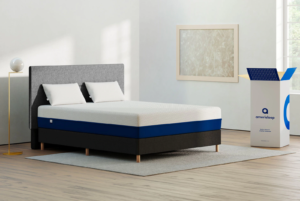 Our editors like the Amerisleep AS3 mattress for many reasons. The 12-inch profile offers a medium feel that’s a true balance between support and comfort.
Our editors like the Amerisleep AS3 mattress for many reasons. The 12-inch profile offers a medium feel that’s a true balance between support and comfort.
Within that 12-inch profile are three distinct layers, and each plays a significant role in the mattress’s overall performance. A 3-inch Bio-Pur® memory foam layer contours to your body to relieve pain-causing pressure points while dissipating body heat. Below that, a 2-inch Affinity layer with HIVE® relieves pressure points and bounces back quickly.
The 7-inch Bio-Core® sag-free layer acts as a durable foundation, supporting the body’s shape no matter what sleep position you prefer.
Amerisleep offers the AS3 with a 100-night, risk-free trial so you have a chance to adjust to the mattress before deciding if it’s right for you. If it isn’t after the adjustment period, Amerisleep will provide a full refund. If you decide to keep the AS3 beyond that 100-night trial, the mattress is covered by a best-in-class 20-year warranty.
The AS3 is $1399 for a queen mattress. Other Amerisleep mattress models cost between $899 to $4,000, depending on thickness and materials.
2. Zoma Mattress
 Approved by athletes and developed through years of research, testing, and design, the Zoma Mattress was created to provide relief and rejuvenation for those with active lifestyles. Whether you’re an athlete or have a physically-demanding job, Zoma can improve your sleep quality.
Approved by athletes and developed through years of research, testing, and design, the Zoma Mattress was created to provide relief and rejuvenation for those with active lifestyles. Whether you’re an athlete or have a physically-demanding job, Zoma can improve your sleep quality.
The secret to Zoma’s success comes from the three distinct layers.
The cover is breathable and provides a cooler experience for uninterrupted sleep. Below the cover is a layer of gel memory foam with zoned Triangulex™ technology. The three distinct zones offer targeted support, comfort, and pressure relief.
Below the cooling gel layer, you’ll find the Reactiv™ layer. Reactiv™ automatically adjusts as you change positions and minimizes motion transfer. At the very base is the Support+ layer to ensure stability and long-lasting durability.
Backed by a 10-year warranty that covers everything from a simple repair to a full replacement, Zoma offers you peace of mind with each purchase. And with mattress sizes ranging from twin XL to a split king, you’ll have no trouble finding one to fit your current bedroom setup. A queen size mattress is $750 with a risk-free, 100-night trial.
3. Vaya Mattress
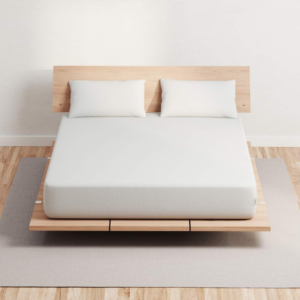 The Vaya Mattress is a budget-friendly option for any sleeper. Designed with an even balance of comfort and support, the Vaya can accommodate side, back, stomach, and combination sleepers alike. It’s made with two premium layers of foam and stands 12 inches tall. Let’s break down this bed’s construction.
The Vaya Mattress is a budget-friendly option for any sleeper. Designed with an even balance of comfort and support, the Vaya can accommodate side, back, stomach, and combination sleepers alike. It’s made with two premium layers of foam and stands 12 inches tall. Let’s break down this bed’s construction.
The cover of the Vaya is a soft, lightweight, and breathable fabric. This offers immediate comfort while promoting airflow, ensuring you’ll never wake up overheated. The comfort layer is 3 inches of Vaya Foam—a responsive, open-cell foam. When you lay on the Vaya, this foam will contour to your body to alleviate pressure.
This layer also adapts to your movements quickly. It prevents you from feeling “stuck” should you change sleeping positions or climb out of bed.
The core of the Vaya is 9 inches of durable base foam to evenly distribute your weight and prevent sagging. Vaya also backs their mattress with a 10-year warranty so you get the most for your money.
The Vaya Mattress is sold online on Amazon only and comes with a 100-night sleep trial. A queen size mattress costs $530.
4. Luxury Solutions 14″ Firm Memory Foam Mattress
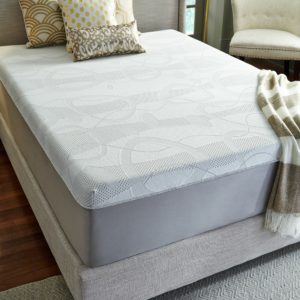 The Luxury Solutions 14″ Firm Memory Foam Mattress is a high-quality memory foam option that won’t put a hole in your wallet when all you want is a good night’s sleep. Featuring breathable memory foams, this 14″ mattress is thicker than other memory foam beds. This mattress is perfect for those who want a firmer sleep surface.
The Luxury Solutions 14″ Firm Memory Foam Mattress is a high-quality memory foam option that won’t put a hole in your wallet when all you want is a good night’s sleep. Featuring breathable memory foams, this 14″ mattress is thicker than other memory foam beds. This mattress is perfect for those who want a firmer sleep surface.
Luxury Solutions’ memory foam design doesn’t require rotation. Like most memory foam mattresses, this mattress minimizes motion transfer. The memory foam is hypoallergenic, keeping your bed clean and allergen-free.
The Luxury Solutions’ 14″ Firm Memory Foam Mattress comes with a 10-year warranty and a 100-night sleep trial. As a result, you can spend some time with this memory foam bed to ensure it’s the right one for you. And if it’s not, simply return it within the 100-day window for a full refund or exchange.
A queen mattress costs $489.99.
5. Bear Mattress
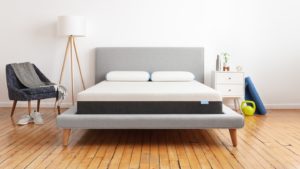 The Bear Mattress features a graphite gel memory foam that disperses heat and keeps you cool. The mattress also utilizes CertiPUR-US® certified foams, it’s both environmentally-friendly and has little to no off-gassing smell.
The Bear Mattress features a graphite gel memory foam that disperses heat and keeps you cool. The mattress also utilizes CertiPUR-US® certified foams, it’s both environmentally-friendly and has little to no off-gassing smell.
So what’s the secret behind Bear’s success? The Bear Mattress is composed of three key layers that each aid in the perfect night’s sleep.
A breathable Celliant® cover ensures the bed remains protected from everyday spills or mishaps. Underneath, the cooling graphite gel memory foam removes unwanted body heat and is supported by a responsive transition foam that offers pressure relief alongside balanced support. And at the base of the mattress, you’ll find a layer of high-density support foam created to provide long-lasting durability.
Bear’s 10-year limited warranty provides you with peace of mind after making your purchase, and a 100-night sleep trial will give you the best chance to ensure the mattress is the right fit for you. Bear requires you to keep the mattress for at least 30 nights before initiating a return.
A queen size Bear Mattress is $800.
6. Nest Bedding Alexander Signature Series® Flippable
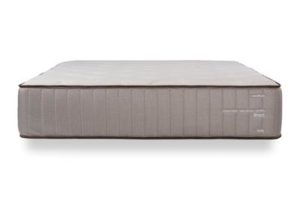 Most memory foam mattresses are not two-sided. Nest Bedding’s flippable mattress is one of the rare exceptions. The mattress even has handles on its side to make flipping easier.
Most memory foam mattresses are not two-sided. Nest Bedding’s flippable mattress is one of the rare exceptions. The mattress even has handles on its side to make flipping easier.
Each side features a different firmness. The medium feel side makes for a perfect mattress for side sleepers and combination sleepers. Its luxury firm side is well-suited for back and some stomach sleepers.
An organic cotton cover surrounds the mattress’s five foam layers. We will discuss its layers from the soft side down.
The first layer is an inch of CoolFlow™ Plush Quilting Foam, followed by 2 inches of gel memory foam. You’ll feel as if you’re floating on CoolFlow™ foam, according to the company’s website.
The third layer is 2 inches of transitional foam for more responsiveness, so you don’t sink too deeply in the mattress’s soft layers. Seven inches of Luxury Firm base foam forms the support layer. The firm side’s comfort layer is an inch of CoolFlow™ foam.
A queen size flippable mattress is $1,599 and includes a 100-night sleep trial and a limited lifetime warranty. The warranty covers sagging that extends beyond an inch.
7. Zinus Pressure Relief Green Tea Memory Foam
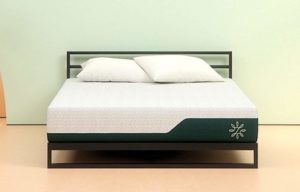
Zinus’s memory foam mattress is one of the freshest on this list thanks to the infused green tea extract. The foam also includes ActivCharcoal, a material made from purified charcoal to absorb moisture and prevent mold and mildew from growing.
The mattress comes in 6, 8, 10, and 12-inch thicknesses. The exact construction and feel depends on the bed’s width.
We recommend the 10 or 12-inch mattress for maximum comfort and durability.
The 10-inch model has a medium-soft feel and three foam layers. First is 2.5 inches of memory foam, followed by 2 inches of comfort foam and 5.5 inches of high-density foam. Comfort foam improves the bed’s pressure relief, letting the mattress contour closer. The high-density foam deters sagging.
The 12-inch mattress has a thicker comfort layer, with 3 inches of memory foam for a softer feeling. It also has a 2-inch transition layer of comfort foam and 7 inches of high-density foam.
A 12-inch queen size mattress is $344. The 10-inch model is $278 for a queen. Every Zinus mattress includes free shipping, a 100-night trial, and a 10-year warranty.
8. tulo Mattress
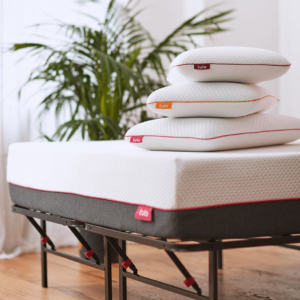 Nobody sleeps the same way, which is why tulo offers its memory foam mattresses in soft, medium, and firm. The soft mattresses are great for side sleepers, while the medium and firm mattresses are recommended for back and stomach sleepers.
Nobody sleeps the same way, which is why tulo offers its memory foam mattresses in soft, medium, and firm. The soft mattresses are great for side sleepers, while the medium and firm mattresses are recommended for back and stomach sleepers.
Regardless of its feel, each mattress is 10 inches thick with four foam layers.
The comfort layer is 2 inches of ventilated memory foam, with added titanium to wick away heat. The second layer is 1.5 inches of bouncy yet firm foam, with a wavy design for greater airflow. This layer keeps you cool and prevents you from feeling stuck in the mattress.
Next is 1.5 inches of reinforced foam to prevent compression, followed by 4 inches of supportive foam to promote longevity.
A queen size tulo mattress is $699 with free shipping. A tulo mattress comes with a 120-night trial and a 10-year warranty.
Who Should Sleep on a Memory Foam Mattress?
Almost anyone can sleep on a memory foam mattress. Many describe the feeling as floating on a cloud or being cradled, which is a sensation most of us would enjoy. However, some may benefit more from a memory foam mattress than others, such as those with backaches and sore muscles.
Sleepers with a chronic pain condition tend to sleep better on a memory foam mattress. The material doesn’t press up against sensitive areas, which leaves them waking up with less pain. It’s also a good mattress for athletes and people with jobs that require physical labor. If you often feel sore when your day is over, a memory foam mattress can soothe your pain and help you get a good night’s sleep.
Memory foam mattresses are suitable for all sleeping styles. However, side sleepers need more pressure relief than back or stomach sleepers, and memory foam is one of the best materials for alleviating stress on the body. The material molds against the shoulders and hips, letting them sink in just enough to prevent pressure build-up.
Traditional memory foam is not a good match for hot sleepers because the material can retain heat and disrupt sleep. However, many manufacturers limit heat retention by using plant-based foams or cooling technologies.
Memory Foam Features to Consider
Pressure Relief
Perhaps the biggest draw of a memory foam mattress is how well it eases pressure points. Softer mattresses with thick comfort layers can mold closer to the body for more pressure relief.
Ease of Movement
While the way memory foam conforms to the body alleviates pressure, it can also leave you feeling stuck in the mattress if it’s not able to adapt to your movements. Bouncy transition layers and thinner comfort layers can prevent you from growing trapped in your bed.
Motion Isolation
All memory foam mattresses isolate motion to some degree, but some limit motion transfer more so than others. Often, the more a mattress conforms to the body, the less movement it transfers.
Edge Support
Edge support is not a common feature in memory foam mattresses, but it’s invaluable if you have difficulty moving in and out of bed. Firm foams let you sit on the edge of your mattress, at the cost of reduced sleeping space.
Sleeping Cool and Airflow
Many mattresses listed here offer cooling technology that promotes airflow and keeps the sleeper cool despite high body heat or external temperatures. The chief complaint among memory foam mattress owners is that the bed tends to sleep too hot.
To solve this problem, mattress providers have integrated standard cooling technology into newer mattresses. As a result, memory foam and latex mattresses rank highly amongst the many mattress options in terms of temperature regulation, as the top layer of memory foam or latex is breathable and promotes air circulation.
New Mattress Smell
Another common complaint with new memory foam mattresses is a noticeable chemical smell. The odor results from off-gassing, a process where volatile organic compounds from the mattress’s production break down at room temperature.
Foams that substitute petrochemicals with plant-based substitutes are less prone to off-gassing. So are lower density foams that contain fewer materials. Most people suffer no negative effects from the smell, which should disappear within 3 to 7 days.
Sensitive to smells? Look for a CertiPUR-US® certification, which guarantees that the mattress contains low amounts of VOCs for minimal off-gassing. Placing your mattress into an encasement or covering it with a protector can also block the smell until it dissipates, thanks to the tightly woven fabric that makes up each.
Mattress Types
Before you decide to buy a mattress out of the blue without doing your research, stop for just a moment and consider the many different mattress types on the market today. Gone are the days when box spring mattresses ruled the world. Now we have options.
Memory Foam Mattresses
Sometimes referred to as viscoelastic polyurethane foam, memory foam is a type of foam that adapts to your weight, shape, and temperature. It’s referred to as memory foam because it retains an impression of your body for a brief moment after you get out of bed.
Most memory foam mattresses features more than just memory foam (memory foam is rather expensive), having durable poly-foam transition and support layers. A well-built memory foam mattress will incorporate the body-contouring foam in the comfort layer.
There are a few types of memory foam mattresses to consider:
- Traditional memory foam: This foam features contouring and noiseless motion isolation, with the trade-off that it tends to retain body heat. Its use in mattresses has declined because manufacturers have discovered ways to create cooler memory foam.
- Gel memory foam: Manufacturers add cooling gels to improve the foam’s heat dispersion. The gel may be swirled, in bead form, or infused throughout the foam. Alternative cooling infusions include copper, charcoal, graphite, ceramic, and green tea extract.
- Plant-based memory foam: The standard production for memory foam uses petroleum-based chemicals. Some manufacturers substitute some of these chemicals with plant-based alternatives such as castor oil. This creates a more eco-friendly and breathable foam. It’s worth noting that only some of the petrochemicals are replaced since it’s impossible to make a memory foam mattress without any.
Latex Mattresses
Latex mattresses are known for being extremely comfortable, promoting back pain relief and natural spinal alignment. Because latex is a natural material, these mattresses are highly resistant to mold, dust mites, and other microbes that are known to populate your bed over time. They’re also naturally allergen-free and eco-friendly. For sleepers allergic to latex, we recommend a synthetic latex option.
Innerspring Mattresses
Innerspring mattresses are often touted as being “medium-firm,” meaning they can alleviate moderate back pain through firmness while providing adequate spinal support for both back and stomach sleepers. Plus-size sleepers often find relief when using innerspring mattresses. Newer designs now incorporate comfort layers on top that offer more support and pain relief.
Hybrid Mattresses
Hybrid mattresses are often more expensive than true memory foam designs and offer many of the same benefits along the way. They’re referred to as hybrid mattresses because the top layer is composed of soft memory foam, while coils underneath that top layer reduce motion transfer and promote deeper REM sleep. The coils in a hybrid mattress will also provide more contouring support than the foam core found in lower-end memory foam mattresses.
Sleeping Position
Anyone who’s shared a mattress knows we all sleep differently. Some of us sleep on our side, others on our back. Most of us change sleeping positions throughout the night, too.
Whatever sleeping position is most comfortable for you, it’s important to find the mattress type that works best for it.
Side Sleepers
Those who sleep on their side will want a mattress that conforms to the body. The bed should lend support to the hips and lower back that would otherwise go unsupported. As a result, the memory foam mattress is ideal given its ability to mold to the body’s many curves, no matter the position.
A mattress for side sleeping should have a soft to medium feel. You may also want to look for a mattress with extra cushioning in the hips and shoulders. Pressure points tend to develop in those areas when you sleep on your side.
Back Sleepers
Back sleepers tend to do best with a medium-firm mattress, as the comfort layer offers pressure relief while firmer layers keeps the body aligned. Sleeping on a medium-firm bed is also a good way to prevent and alleviate back pain, according to a 2015 study. Because the entire backside of the body is putting pressure on the mattress, a memory foam, latex, or hybrid design would offer both comfort and support for the entire spine.
Back sleeping can cause or worsen sleep apnea and snoring. You can raise your upper body with a wedge pillow or adjustable base to reduce symptoms. This prevents the collapse of soft tissues in the back of your throat, which disrupts your breathing.
Stomach Sleepers
Stomach sleeping isn’t the healthiest sleeping position and is often hardest on the back. Those who are stomach sleepers would do well to change positions if possible. Stomach sleepers put a lot of pressure on the lower spine if the back begins to curve inward as the stomach dips into the mattress.
To combat this, stomach sleepers need a mattress that offers rigid support and tends to be on the firmer side, like that of an innerspring mattress. However, innerspring mattresses have a difficult time controlling motion transfer. They aren’t the best option for those who share a mattress or those who toss and turn.
If you wish to switch sleep positions, try sleeping with something that prevents you from turning onto your stomach. It could be a firm body pillow, a pillowcase filled with tennis balls, or a tennis ball attached to the front of your sleepwear with duct tape.
Mattress Firmness
There is no one firmness option that’s perfect for everyone. How do you know which firmness you will find most comfortable? Consider your favorite sleeping position, your weight, and your personal preferences.
Your sleeping position affects how pressure builds up in your body. The wrong mattress firmness can add to the pressure instead of relieving it. Plus, a too soft or too firm mattress can raise or lower your spine out of alignment.
Your weight determines how much you push down on the mattress. Plus-size sleepers who weigh more than 230 pounds compress the mattress more, so they need a firmer mattress to push back. Petite sleepers place less pressure on the bed, so a softer mattress is required for full pressure relief.
What a company defines as firm and soft can vary. If you can’t try the mattress for yourself, skim customer feedback and independent mattress reviews for descriptions of how the bed feels.
Try to find reviews from people who’ve owned the mattress for a few months. They will give you a clearer picture of the mattress than the opinion of someone who has slept on it for less than a week.
ILD Rating
Mattress companies assign a firmness label to a mattress based upon its Indentation Load Deflection (ILD) rating. The ILD rating is determined by how much force it takes to compress the mattress to 25 percent of its original thickness. This test determines how the foam stands up to weight and pressure.
Every foam layer has its own ILD rating. A higher ILD material means the material is firmer. Typically, the support core has the highest ILD rating, while the comfort layer has a lower ILD rating for better adaptability.
Some companies openly advertise each layer’s ILD rating. If you’re curious and can’t find it on the website, reach out to customer service.
Memory Foam Density
Many confuse a memory foam mattress’s density with its firmness, but the two are different things. A mattress’s feel can be subjective, but its density is an objective trait.
Density is defined as the measurement of a material’s mass in a given volume. In simpler terms, a material’s density expresses how close or far apart its particles are. Mattress companies weigh a cubic foot of foam to calculate its density.
Memory foam density is classified as low, medium, or high density. Lower density foams cost less to produce since they contain fewer materials, but they’re also more prone to developing wear and tear with frequent use.
Higher-density foams provide more pain relief, better motion isolation, and closer contouring. A higher density foam is also more durable because it has more material to resist wear and tear. However, this added material increases the price of higher density foams and the time it takes for the mattress to finish off-gassing.
The top memory foam layer often has a higher density than the base layer, since it bears the force of your body and must resist sagging.
Mattress Thickness
Mattress thickness affects its cost and durability. Thicker mattresses require more materials, increasing the price. With more materials, the mattress is less likely to break down prematurely.
A mattress’s thickness is also known as its profile. There are low, medium, and high-profile mattresses:
- A low-profile mattress is thinner than 10 inches.
- A medium-profile mattress is 10 to 12 inches.
- A high-profile mattress is thicker than 12 inches.
We always recommend shopping for a mattress that’s 10 inches or thicker. Thinner mattresses tend to wear out quicker and provide less comfort. A low-profile mattress may have a basic two-layer construction, while medium to high-profile mattresses add an extra layer to increase responsiveness and prevent you from sinking in too deeply.
Do you need a mattress for a heavy person who’s over 230 pounds? We recommend a bed at least 12 inches thick.
Mattress Sizes
There are seven standard mattress sizes to consider when shopping. The right size for you will depend on who will sleep in the bed, the bedroom’s size, and your budget.
| Size | Dimensions in Inches |
| Twin | 38 by 75 |
| Twin XL | 38 by 80 |
| Full | 54 by 75 |
| Queen | 60 by 80 |
| King | 76 by 80 |
| California King | 72 by 84 |
| Split King | Two mattresses, each 38 by 80 |
These are the minimum room sizes we recommend for each:
- Twin and twin XL mattresses: 7 feet by 10 feet
- Full and queen mattress: 10 feet by 10 feet
- All king mattresses: 12 feet by 12 feet
Twin and twin XL mattresses are an excellent choice for a child graduating from a crib. We often recommend a twin XL mattress since it provides a few more inches for a teenager’s growth spurt.
Full mattresses are an excellent choice for solo sleepers who want to stretch out their limbs, rather than tuck them close against their sides.
Are you shopping for a mattress for a couple? We suggest looking at queen and king size mattresses. Beds smaller than a queen do not give two people adequate sleeping space.
Naturally, larger mattress sizes cost more since they require more materials. Matching bed frames and bedding accessories for bigger mattresses also have higher prices.
Mattress Budget
When shopping for a brand new mattress, it’s always important to begin by setting a budget. From there, you can decide which mattress types fit within your price range and which do not.
For instance, natural latex mattresses tend to cost the most due to the expensive nature of producing latex. So a latex mattress may not be an economical option for everyone. Innerspring mattresses have been around for decades and aren’t quite as expensive as they once were, especially compared to their memory foam and latex mattress counterparts.
You’ll find memory foam mattresses at various price points $200 to $3,000. The price of a memory foam mattress often depends on the foam’s quality. However, you do not need to buy the most expensive bed to sleep on a high-quality mattress.
We recommend budgeting between $700 to $1500 for a queen memory foam mattress. For those on a tight budget, there are a few hidden gems that cost around $500.
If you find yourself interested in a memory foam mattress but don’t have the funds, memory foam toppers offer an economical option that sits directly atop your current mattress. Often these toppers provide a memory foam-like experience for a fraction of the price. Toppers can improve the feel of a mattress that’s softened or firmed up with age.
You can also save money by shopping online rather than browsing your local mattress store. Online sellers offer lower prices because they sell directly to the customer. Independent mattress showrooms have to mark up the price of a mattress to meet storefront and staffing costs.
While a good night’s sleep is essential, breaking the bank over a mattress isn’t necessary given the countless options on the market today. Be sure to buy within your means, and take time to find the mattress that’s right for you.
When Can I Sleep on a Memory Foam Mattress?
When you order a bed in a box mattress, you should see a notice about your mattress needing time to expand once it’s set up. Companies may estimate between 8 to 48 hours are necessary for full expansion. Do you have to wait that long to sleep on your mattress?
The truth is you should be able to sleep on your mattress a couple of hours after unboxing. Sleeping on a mattress before it’s finished filling out won’t damage the foam. However, you may not sleep as well on the mattress as you would once it’s expanded.
Your mattress is likely defective if it does not reach full expansion within a week. If that happens, reach out to customer service and ask about replacements covered by the mattress’s warranty.
Even after your mattress has expanded, it may take you some time to adjust to its feel. Many adapt within a few days or a week. Some sleepers need a full month, which is why it’s a good idea to buy a mattress with a long sleep trial.
You can speed up the break-in period by walking across the top of your mattress.
How Long Does a Memory Foam Mattress Last?
A critical shopping consideration is how long you can expect your mattress to last. The average memory foam mattress lasts 7 years. However, ones with high-quality and supportive foams can last 8 to 10 years, sometimes more.
Density is one way to judge how long a mattress will last. As we mentioned, higher density foams are more durable.
Reading the warranty is another way to determine a mattress’s durability. Most mattresses have 10-year warranties, although a few have some that extend to 20 or even 25 years. You can also check how deep the mattress has to sag before it’s eligible for replacement. If a company knows its mattress is resilient, it should cover sagging under an inch.
Memory foam mattresses tend to last longer than innerspring mattresses and hybrid mattresses. Innerspring mattresses usually sag within 5 to 6 years, and hybrid mattresses often lose support within 6 to 7 years.
When to Replace a Memory Foam Mattress
No matter what high-quality materials a mattress contains or how well you take care of it, all mattresses need replacing someday. If you find yourself sleeping poorly on what once was the perfect mattress, it’s probably time for a new one.
Memory foam loses its ability to regain its original shape as time passes. You may find yourself rolling toward the middle or sleeping in an indentation when that happens. Once sagging exceeds an inch, it tends to cause considerable back pain. It’s best to buy a replacement rather than continue sleeping on the mattress.
If your mattress is sagging, check the details of your warranty before you buy a new mattress. You may be eligible for a replacement.
Even if your mattress still feels supportive, it may be time to throw it out if you’re waking up in pain. A simple test is seeing how you sleep on a couch, guest room bed, or in a hotel. Getting a better night’s sleep elsewhere is a good sign you need a new mattress.
If you’re getting a full night’s sleep but feel groggy throughout the day, the culprit may be your mattress. However, it could also be a symptom of a sleep disorder such as sleep apnea, so you may want to speak with your doctor first.
Most allergens have trouble penetrating the dense layers of a memory foam mattress, but a few may find their way inside over the years. An increase in morning allergy symptoms may mean your bed is full of irritants. It is easier and often cheaper to buy a new mattress than try to deep clean your current one.
Sleep Trial and Warranties
When you’re considering memory foam mattress features, don’t forget to scope out its attached sleep trial and warranty. We always recommend purchasing a mattress with these two policies, particularly a warranty. A mattress that lacks these protections may mean the company has little faith in the quality of its product.
Sleep Trial
A sleep trial period lets you try out a mattress after it’s delivered. You can return it for a refund or exchange it for another mattress model if you find it uncomfortable. Sleep trials often span 90 to 120 days, although a few extend to a full year.
Most online mattresses include a sleep trial since you can’t test it before you buy it. However, even if you do lie down on a showroom model to check the feel, it can’t capture the experience of sleeping on the mattress every night. This is why many in-store models also include a sleep trial to better compete with online sellers.
Warranty
Reading through a warranty’s terms should leave you understanding what the company covers in the event of a manufacturing defect. Companies usually bear full financial responsibility for:
- Splits or cracks in the foam
- Damage to the cover that exceeds standard wear and tear
- Ripped seams
- Sagging of a certain depth, usually at least an inch
To maintain your warranty, you have to keep the mattress on a supportive foundation and rotate it every so often.
Most mattress warranties cover 10 years. A mattress with a longer warranty is a good sign that the bed contains high-quality materials. On the other hand, a mattress with a shorter warranty may mean the bed has cheap foam.
Some warranties will require you to buy shipping costs or handling fees when you file a claim. We strongly recommend looking for a warranty where the company bears all charges for the first 10 years. Warranty claims require a proof of purchase, so save your receipt in a safe place.
Other Considerations
Once you’ve picked out your mattress, you still should consider your foundation and bedding options. After you’ve selected those, your perfect bed should be complete. Rotating the bed, spot cleaning, and freshening it up with baking soda will keep your mattress feeling great for years.
Foundation
If you’re making the switch to a memory foam bed, check if your bed frame provides sufficient support. A good foundation for a memory foam mattress features consistent support to stop the mattress from falling between slats.
For example, a box spring is a poor choice of support for a memory foam mattress. The coils inside are not placed close enough to prevent premature sagging. A piece of moisture-resistant plywood placed on top of the box support can deter sagging if you have a box spring you wish to use.
Excellent foundation choices include platform beds and adjustable bed bases. We recommend slatted foundations over solid ones for better airflow, which helps limit heat retention. However, the slats must be at least 0.5 inches thick and no more than 3 inches apart. If the slats are farther away from each other, the mattress can dip between them.
Adjustable bases, in particular, let you customize your position. You can sleep sitting up to reduce snoring and acid reflux and raise your legs for improved blood flow and lower pressure on your lower back. The main drawback of an adjustable bed is its price tag. Many cost more than $1,000.
The floor can work as a temporary foundation while you shop for a bed frame. We caution against keeping your mattress on the floor permanently.
The floor limits airflow through the bottom of the mattress, allowing heat and moisture to accumulate. Trapped heat can leave you waking up sweating, while the collected moisture can allow mold and mildew to flourish.
Keeping your mattress on the floor also exposes it to dirt, dust, and bugs. And not placing your mattress on a proper bed frame or base may void its warranty.
Bedding
When you’re selecting sheets and blankets for your memory foam mattress, you may want to consider how breathable the material is. You’re far less likely to sleep hot with cotton sheets than you are on polyester.
Higher thread count sheets are often praised for their softness, but the tighter weave also inhibits breathability. If sleeping hot is a concern, look for a lower thread count.
To prevent allergens and dust mites from settling into your mattress, you should try to wash your sheets once a week. Washing your bedding in hot water is the best way to eliminate pests. Vacuuming your mattress as you change the sheets can further prevent dust mites and debris from settling on your mattress.
Mattress Care
Keeping your mattress clean requires more than just frequently washing your bedding. Dirt, debris, pests, and bacteria can still accumulate in your mattress.
Encasing your mattress in a protector will keep out pests and liquids, preventing damage to the mattress. Many protectors cost between $20 to $30, a fraction of what you would pay to replace a damaged mattress.
If your memory foam mattress develops a stain, spot clean it. Do not spray cleaner onto the mattress, however. You should spray cleaner on a cloth and blot the stain.
To freshen up your mattress, sprinkle a thick coating of baking soda on your stripped mattress. A sifter will let you spread the baking soda more evenly, but it’s not necessary.
The longer you leave the baking soda on the mattress, the more it will absorb and clean. We recommend a few hours, but you can leave it alone for an entire day. Once you’ve let the baking soda sit, vacuum it up and replace your bedding.
Rotating your mattress every three to six months evens out wear. Otherwise, your mattress is more likely to sag in your usual sleeping spot.
While flipping a mattress was once part of the standard care routine, most memory foam mattresses should not be flipped. The basic memory foam mattress design is a supportive foam layer topped with a memory foam layer. Flipping the mattress means sleeping on the stiffer support core.
Some memory foam mattresses are flippable. However, the few dual-sided memory foam mattresses usually feel differently on each side. You may not sleep as well if you flip your mattress.
Common Questions
Chances are you have a few lingering questions about memory foam mattresses but have no fear. Below you’ll find some of the most common memory foam mattress questions.
How many years does a memory foam mattress last?
Depending on how well they’re cared for, memory foam mattresses can last anywhere from 8 to 10 years. Often a memory foam mattress will last just as long as any other type of mattress, be it an innerspring or hybrid mattress design.
Is a memory foam mattress good for your back?
Memory foam mattresses have become a top choice for those suffering from back pain. By providing adaptive, even support, especially when used with an adjustable bed frame, memory foam mattresses distribute body weight well and eliminate pressure points and discomfort.
What is the best thickness for a memory foam mattress?
As recently discussed, memory foam mattresses are usually made with a layer or two of memory foam on top, followed by poly-foam layers for support below. The right balance between thickness and support is anywhere from 10 to 12 inches.
Which is better: memory foam or gel memory foam?
There is no better option here, but there may be an option better suited to your needs. Memory foam mattresses are made from a material called viscoelastic foam. A gel foam mattress is also made from viscoelastic foam, but it has been infused with gel. Gel foam was introduced in mattresses to offer a cooler sleep and assist with pressure relief, so those who sleep hot or struggle with pressure pains will find relief.
Can bed bugs live in memory foam?
Bed bugs can live around or in any type of mattress. However, they cannot burrow, so they can only slip inside a memory foam mattress if there’s already a crack or hole. They’re about the size of an apple seed and can slip into cracks thick enough to accommodate your credit card.
Bed bugs prefer living outside of a mattress but away from light and anything that can detect them. You’re more likely to see them hiding underneath buttons, fabric creases, or the underside of the mattress.
Conclusion
Finding the right memory foam mattress—should you decide that a memory foam mattress is what you need—can take time and require patience. Before purchasing a mattress, review the trial period and warranty information. That way you’re covered if the mattress you purchase isn’t the one of your dreams. Once you’ve done your research and found the mattress best suited for you, your body will thank you.
This article is for informational purposes and should not replace advice from your doctor or other medical professional.